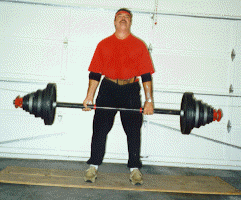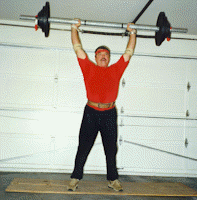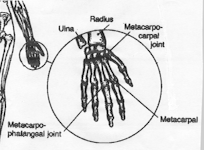By: The Cable/ Bar Guy

Deadlifting 500 lbs. with a 2" thick bar.

One area of training where there
has been an increase in interest of late is the lifting of thick or oversized
barbells. This is not new. However, with the advent of the book, "Dinosaur
Training", and with the increased popularity of strongman (woman) contests,
suddenly lifting awkward implements has turned into a new fad.
I'm no stranger to using thick
bars in my training, or using awkward shaped objects to exercise with.
In my early weight training life, before I got a store bought set of weights,
I used a discarded fence post. It was an old piece of 2" pipe filled with
concrete. Also, I used a couple of army surplus knap sacks and filled them
with rocks. These training aids worked fine in the beginning but I never
figured I'd go back to this kind of stuff!
Well, after reading the dinosuar
book and several magazine articles on the subject, I decided it might be
fun to play around a little with some oversized barbells again. However
this time I decided to make a proper commitment by making some proper barbells
that could be loaded with Olympic plates.
Being that I'm a do-it-yourself
kind of guy, I figured I'd just build my own thick barbells. Now the most
logical thing to use when building an oversized barbell is pipe. The OD
on 1 1/2" pipe is about 1.9" and it is ideal for a light duty barbell.
However, if you want to make your barbell heavy-duty, you will need solid
steel round stock.

A piece of 1 1/2" pipe about 7'
long should only cost about $10 to $15. Solid steel round stock however
will cost a little more depending upon the type of steel that is used.
As an example, I bought a 7' piece of 2" cold rolled round stock for only
$50. I then made a couple of stop collars out of 2" pipe. This bar unloaded
weighs about 35kg./ 77lb., and it works great for deadlifts, squats, presses,
and most other compound movements. However, on multiple compound movements
like cleans, a thick non-revolving bar is not a good idea.
So to make a revolving bar I sleeved
my 1.9" OD'd pipe with another piece of pipe with a 2" ID. This sleeve
is about 52" long. The cost was about $19. for a 5' piece. The excess is
what I made the stop collars out of. The OD is 2
3/8". Thus the cost of my light duty bar was only about $34.This bar will
easily hold 500 lb. However the most that I've ever used is about 250 lb.
It's held up quite well, but that is because I don't drop it.
Now you could sleeve a piece of
2" solid steel round stock with a 2" pipe to make a revolving bar, and
such a bar would be very difficult to bend. However, beware, such a bar
will weigh at least 90 lb. unloaded.
When lifting a thick oversized
bar one must be cognizant of several things. First, when cleaning, your
technique will suffer a little. This is because it is necessary to squeeze
the bar much harder than normal, and this will many times put you into
a bent arm pulling position. Thus the arms are worked more than normal.
Also, when pressing overhead,
I recommend squeezing the bar through the entire movement. If you relax
your grip your stability could be compromised. Also, when in the overhead
position, I've found that not holding on as tight as I can will put a lot
of stress on the metacarpocarpal joint, at the base of the wrist below
the thumb (see drawing).
